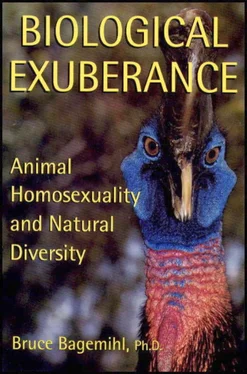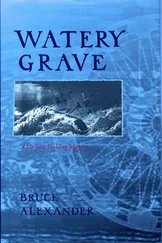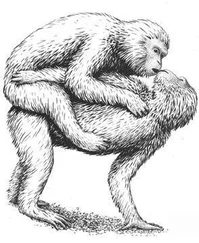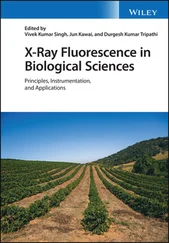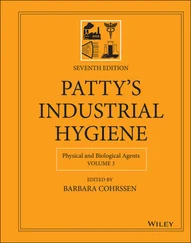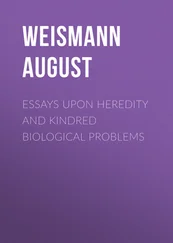Nonreproductive and Alternative Heterosexualities
Heterosexual mating in Ratites occurs in the context of an extraordinary variety of complex social arrangements that deviate significantly from the nuclear-family model. Ostriches have a mating system that has been described as SEMIPROMISCUOUS MONOGAMY. Male and female Ostriches form a type of pair-bond with each other that one biologist describes as a sort of “open marriage,” since both partners also copulate with a number of other birds besides their primary partner (birds often mate with a different primary partner each year as well). In addition, females often lay eggs in nests other than their own, especially if they are not the primary partner of a male. As a result, many of the eggs that a pair incubates (and the young they raise) are not necessarily their own. Adoption also occurs when broods are combined to form nursery groups or CRÈCHES—sometimes containing hundreds of chicks—that are looked after by one or more adults. Emus utilize SERIAL POLYANDRY in their mating system: a male pairs with one female who remains with him until incubation begins, at which point the female leaves her partner and pairs with a new male to begin a second clutch. Many females also seek nonmonogamous matings, copulating with males other than their pair-mate. One study found that the majority of copulations—nearly three-quarters—are promiscuous. In addition, copulation between pair members may be nonprocreative, occurring several months before egg laying. Greater Rheas have a variable mating system that can be characterized as SERIAL POLYGYNANDRY: a male associates with a “harem” of three to ten females, all of whom he mates with. The females lay their eggs communally in one nest; after the male begins to incubate, the females then move on to another male, repeating the process with up to seven different males. As noted above, most Emu and Rhea males are single parents, which can be an arduous task. While tending the eggs, male Rheas rarely leave the nest for more than a few minutes during the six-week incubation period. Male Emus often become severely emaciated and weakened from not eating, drinking, defecating, or leaving the nest during their entire eight-week incubation period. Nonbreeding and failed breeding attempts also occur at high rates among Greater Rheas: less than 20 percent of males even try to reproduce each year, and overall only 5–6 percent of males are successful at breeding each year.
As discussed above, sex-segregated flocks are common among Ostriches, many of whom are not involved in heterosexual pursuits. Also, heterosexual courtship is often not synchronized: females typically begin approaching males several weeks before the latter become sexually interested, and during this time the males often appear to ignore or be indifferent to the females’ advances. The onset of the males’ sexual cycle is marked by a red flush on the legs and face, as well as enlargement and erection of the penis, which is often displayed in a special “penis-swinging” ceremony. However, once males begin courting, nearly a third of their advances are, in turn, refused by females. Among Emus and Rheas, outright hostility often develops between the sexes once the male starts incubating. Fathers typically threaten, chase, or attack females that try to approach them, while female Emus have been seen responding with vicious double-footed kicks that can tumble males head over heels. Infanticide also sometimes occurs: females that are able to get close to a male tending his chicks may end up killing the youngsters. Egg abandonment or destruction takes place among Ostriches, often of eggs laid by another female. Abandonment also occurs in Greater Rheas, where nearly two-thirds of nests are deserted by males during incubation. In addition, female Rheas who are unable to find a nest and male caretaker for their eggs often lay them in the open and then abandon them; these are known as ORPHAN EGGS. Once (nonorphan) eggs hatch, fathers often adopt youngsters from other broods, raising them alongside their own. Nearly a quarter of male Rheas are adoptive parents, and up to 37 percent of each of their broods may be composed of foster chicks. Researchers have found that adopted young actually have a better chance of surviving than do their stepsiblings.
Sources
*asterisked references discuss homosexuality/transgender
Bertram, B. C. (1992) The Ostrich Communal Nesting System. Princeton: Princeton University Press.
Brown, J. L. (1987) Helping and Communal Breeding in Birds: Ecology and Evolution. Princeton: Princeton University Press.
Bruning, D. F. (1974) “Social Structure and Reproductive Behavior in the Greater Rhea.” Living Bird 13:251—94.
Coddington, C. L., and A. Cockburn (1995) “The Mating System of Free-Living Emus.” Australian Journal of Zoology 43:365—72.
Codenotti, T. L., and F. Alvarez (1998) “Adoption of Unrelated Young by Greater Rheas.” Journal of Field Ornithology 69:58—65.
———(1997) “Cooperative Breeding Between Males in the Greater Rhea Rhea americana.” Ibis 139:568—71.
*Curry, P. J. (1979) “The Young Emu and Its Family Life in Captivity.” Master’s thesis, University of Melbourne.
Fernández, G. J., and J. C. Reboreda (1998) “Effects of Clutch Size and Timing of Breeding on Reproductive Success of Greater Rheas.” Auk 115:340—48.
*———(1995) “Adjacent Nesting and Egg Stealing Between Males of the Greater Rhea Rhea americana.” Journal of Avian Biology 26:321—24.
Fleay, D. (1936) “Nesting of the Emu.” Emu 35:202—10.
Folch, A. (1992) “Order Struthioniformes.” In J. del Hoyo, A. Elliott, and J. Sargatal, eds., Handbook of the Birds of the World, vol. 1: Ostrich to Ducks, pp. 76—110. Barcelona: Lynx Edici6ns.
*Gaukrodger, D. W. (1925) “The Emu at Home.” Emu 25:53—57.
*Heinroth, O. (1927) “Berichtigung zu ‘Die Begattung des Emus ( Dromaeus novae-hollandiae )’ [Correction to ‘Mating Behavior of Emus’].” Ornithologische Monatsberichte 35:117—18.
*———(1924) “Die Begattung des Emus, Dromaeus novae-hollandiae [Mating Behavior of Emus].” Ornithologische Monatsberichte 32:29—30.
*Hiramatsu, H., K. Tasaka, S. Shichiri, and F. Hashizaki (1991) “A Case of Masculinization in a Female Ostrich.” Journal of Japanese Association of Zoological Gardens and Aquariums 33:81—84.
Navarro, J. L., M. B. Martella, and M. B. Cabrera (1998) “Fertility of Greater Rhea Orphan Eggs: Conservation and Management Implications.” Journal of Field Ornithology 69:117—20.
O’Brien, R. M. (1990) “Emu, Dromaius novaehollandiae.” In S. Marchant and P. J. Higgins, eds., Handbook of Australian, New Zealand, and Antarctic Birds, vol. 1, part A, pp. 47—58. Melbourne: Oxford University Press.
Raikow, R. J. (1968) “Sexual and Agonistic Behavior of the Common Rhea.” Wilson Bulletin 81:196—206.
*Sauer, E. G. F. (1972) “Aberrant Sexual Behavior in the South African Ostrich.” Auk 89:717—37.
Sauer, E. G. F., and E. M. Sauer (1966) “The Behavior and Ecology of the South African Ostrich.” Living Bird 5:45—75.
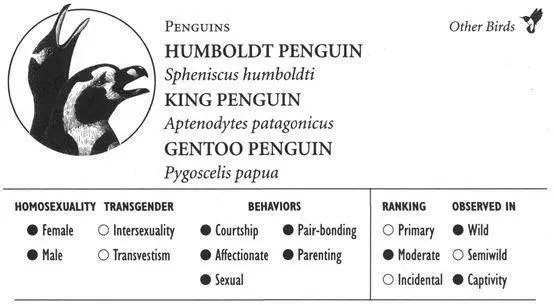
HUMBOLDT PENGUIN
IDENTIFICATION: A small penguin (approximately 2 feet tall) with a black band on its chest and patches of red skin at the base of its bill. DISTRIBUTION: Coastal Peru to central Chile. HABITAT: Marine areas; nests on islands or rocky coasts. STUDY AREAS: Emmen Zoo, the Netherlands; Washington Park Zoo, Portland, Oregon.
Читать дальше
